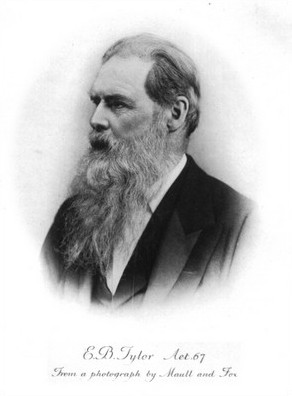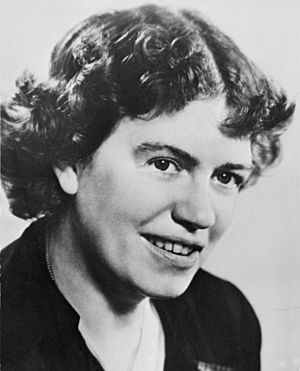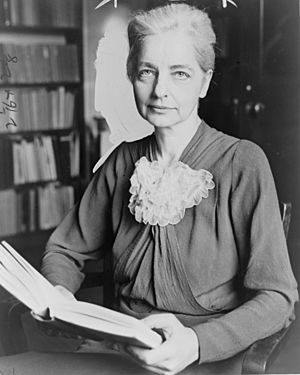Cultural anthropology facts for kids
Cultural anthropology is a part of anthropology that studies how human cultures are different around the world. It looks at how people in different places live, think, and behave. This is different from social anthropology, which focuses more on how societies are organized. Sometimes, people use the term sociocultural anthropology to include both.

Anthropologists have found that people can change and fit into their environment in ways that aren't just about their genes. This means people living in different places often have different cultures. A big part of cultural anthropology is understanding the differences between local cultures and what might be true for all humans. It also looks at how people in different places are connected.
Cultural anthropology uses many ways to study people. These include participant observation, which means living with and observing a group for a long time (often called fieldwork). Anthropologists also do interviews and surveys to learn more.
Contents
History of Cultural Anthropology
Cultural anthropology started to grow in the late 1800s. At this time, many thinkers wondered which cultures were "primitive" (simple) and which were "civilized" (advanced). As European countries expanded their empires, they met many different groups of people. The first cultural anthropologists were interested in why some groups had advanced technologies like engines, while others lived a more ancient, Stone Age way of life.
What is Culture?
One of the first clear definitions of "culture" in anthropology came from Sir Edward Burnett Tylor in 1871. He said that culture, or civilization, is everything a person learns and shares as part of a society. This includes their knowledge, beliefs, art, laws, and customs. Later, the word "civilization" became a specific type of culture, while "culture" became a broader term for all human ways of life.
According to expert Kay Milton, culture can be general (for all humans) or specific (for a certain group, like African American culture). Specific cultures are organized systems. This means all their parts work together, and changing one part can affect the whole system.
Cultures Change and Adapt
In the 1800s, some researchers thought all cultures went through the same steps of development, from simple to complex. This idea was called "cultural evolution". For example, they thought farming had to come before industrial farming.
However, 20th-century anthropologists largely disagreed with this. They saw that cultures don't always follow the same path. For instance, some groups went from being hunter-gatherers to working in modern jobs very quickly. Instead, anthropologists like Julian Steward suggested that similarities between cultures might come from similar ways of adapting to similar environments.
Most anthropologists today agree that cultures can spread ideas from one place to another (called "diffusion"). They also agree that different groups can invent similar things on their own. But they also noticed that even when ideas spread, they often get new meanings in different societies.
Because of this, many anthropologists became more interested in understanding specific cultures on their own terms, rather than comparing them to find universal rules. This led to the idea of "cultural relativism".
Cultural Relativism
Cultural relativism is a key idea in anthropology. It means you can only truly understand a person's beliefs and actions by looking at them within their own culture. Franz Boas, a very important anthropologist, first talked about this idea in 1887. He believed that culture is not something fixed, but something that changes, and our ideas are only true within our own culture.
Boas and his students realized that to study other cultures scientifically, they needed to avoid judging them based on their own culture's standards. This is called ethnocentrism. Ethnocentrism is when you think your own culture's art, values, and beliefs are the best or most truthful.
To avoid ethnocentrism, anthropologists developed methods like ethnography. This means living with people from another culture for a long time. By doing this, they can learn the local language and start to understand the culture from the inside. Cultural relativism helps anthropologists see how important the local context is for understanding what people do and believe.
Important Anthropologists
Lewis Henry Morgan
Lewis Henry Morgan (1818–1881) was a lawyer who studied the Iroquois people. He compared their religion, government, tools, and family systems. He believed societies moved through stages: savagery, barbarism, and civilization. He often used technology, like pottery, to show a culture's stage.
Franz Boas, the "Father of American Anthropology"

Franz Boas (1858–1942) is often called the "Father of American Anthropology." He disagreed with Morgan's idea that all cultures follow the same steps. Boas believed that each culture is unique and must be studied on its own. He showed that human behavior comes from what we learn (nurture), not just from our biology (nature).
Boas fought against unfair treatment of immigrants and native peoples. Many American anthropologists followed his lead in working for social change. His ideas still strongly influence anthropology in the United States today.
Kroeber, Mead, and Benedict
Boas taught many students at Columbia University. Some of his first students included Alfred Kroeber, Margaret Mead, and Ruth Benedict. They studied Native American cultures in great detail. Their work showed that there isn't just one way for cultures to develop.


Margaret Mead and Ruth Benedict were interested in how a person's culture shapes their personality. Mead's book Coming of Age in Samoa (1928) and Benedict's The Chrysanthemum and the Sword (1946) are still popular today.
How Anthropologists Study Cultures
Participant Observation
Participant observation is a main way cultural anthropologists do research. It's based on the idea that the best way to understand a group is to spend a lot of time with them and interact closely. This method started with anthropologists like Bronislaw Malinowski and Franz Boas.
Historically, anthropologists studied small, non-Western societies. Today, they might study a company, a church group, or a sports team. The goal is to get an inside look at the culture. This helps the anthropologist build trust and get a richer understanding when they write about the culture later. They can see both obvious things (like daily routines) and hidden things (like what's considered taboo). They can also notice differences between what people say they do and what they actually do.
To do participant observation, an anthropologist chooses a place and a topic to study. They often learn the local language to communicate directly. They also need permits and funding for their research.
Most participant observation involves talking to people. This can be casual chats or more formal interviews. Anthropologists might also use photos, maps, and collect objects. Sometimes, they do structured observation, where they look for specific things to answer certain questions.
One challenge with participant observation is that it can be hard to be completely objective. Each anthropologist has their own background, which can affect how they see a culture. Modern anthropologists often include their personal experiences and possible biases in their writing to be transparent.
This method also brings up ethical questions. Anthropologists have power in deciding what they report about a culture. Also, just by being there, a researcher can cause changes in a culture. Anthropologists continue to think about whether it's right to influence the cultures they study, or if it's even possible to avoid it.
Ethnography
In the 1900s, most cultural anthropologists wrote ethnographies. An ethnography is a detailed written report about a group of people at a certain place and time. Usually, the anthropologist lives among the people, both participating in and observing their daily life.
Ethnographies also include information about the area's geography and climate. They aim to give a complete picture of the people, including their history.
Bronisław Malinowski developed the ethnographic method, and Franz Boas taught it in the United States. Their students helped shape cultural anthropology. Early on, European "social anthropologists" focused on social behaviors and structures, like family roles. American "cultural anthropologists" focused on how people expressed their views through symbols, like art and myths. Today, most anthropologists combine both approaches, interested in both what people do and what they say.
Comparing Cultures
One way anthropologists avoid judging other cultures is by comparing them. They test ideas about "human universals" (things thought to be true for all humans) against what they find in different cultures. For example, some people think having only one spouse (monogamy) is universal, but comparing cultures shows it is not.
The Human Relations Area Files (HRAF) at Yale University helps with this. Since 1949, it has collected information on nearly 400 cultures from around the world. This allows researchers to compare human cultures, societies, and behaviors.
Multi-sited Ethnography
Today, many anthropologists use "multi-sited ethnography." This means they don't just study one local culture in isolation. They understand that local cultures are connected to bigger global systems, like politics and economics.
In this method, researchers follow a topic across different places and times. For example, an anthropologist might follow a product, like a type of food, as it travels through global trade networks. Or they might follow a group of people who have moved to different countries. This helps them understand how global events affect local lives.
Topics in Cultural Anthropology
Kinship and Family
Kinship is the study of how humans form and keep relationships, and how these relationships organize society. It's a very important topic because, as anthropologist Patrick McConvell said, "Kinship is the bedrock of all human societies." All humans recognize family members like parents, children, and siblings.
Historically, kinship studies looked at marriage, how people are related through birth, and how children are raised. Anthropologists have found many different ways cultures define marriage. For example, the Nuer people of Sudan practice polygyny, where one man has several wives. The Nyar of India practice polyandry, where one woman has several husbands. Most cultures, however, practice monogamy, where one person is married to one other person. Anthropologists also study what is considered forbidden in marriage in different cultures.
There are also differences in how cultures see raising children. While biology is always part of it, cultures have different ideas about who counts as a parent. For example, in some parts of Mexico, a child can have multiple biological mothers if they are born to one woman and then breastfed by another.
Changes in Kinship Studies
In recent times, Western ideas of family have changed beyond the traditional nuclear family. This has led to new questions about how people are related. Kinship studies now look at how power, history, and individual experiences shape family life. The rise of feminist anthropology in the 1970s also brought new ideas about marriage and family roles.
With new technologies like IVF, kinship studies have also started looking at "reproductive anthropology." These technologies challenge traditional ideas of who is a biological parent. For example, a gestational surrogate might carry a baby that has genetic ties to other people. This means a child could have three "biological" mothers: a genetic mother, a surrogate mother, and an adoptive mother. Anthropologists also look at how these technologies are often only available to wealthy people.
Kinship studies also examine how Western cultures often value genetic "blood" ties more than other forms of family. They also look at how single-parent homes are sometimes viewed differently than traditional nuclear families.
Institutional Anthropology
The study of anthropology in institutions has grown a lot. This is because more anthropologists work outside universities, and because globalization connects institutions worldwide. Anthropologists can work for businesses, non-profit groups, and governments.
In anthropology, there are two types of institutions:
- Total institutions: Places that control most of what people do, like prisons or hospitals.
- Social institutions: Rules and structures that guide daily life, like family, religion, or economic systems.
Anthropologists might study labor unions, businesses, governments, or schools. They are especially interested in non-governmental organizations (NGOs) because these groups often help with social problems that governments or families used to handle.
When studying institutions, anthropologists use methods like participant observation. They try to understand how the institution works from the inside. They also look at how relationships, power structures, and cultures form and change within these organizations. It's important for anthropologists to consider that people in institutions might present things in a certain way, especially if information is being shared with the public.
See also
 In Spanish: Antropología cultural para niños
In Spanish: Antropología cultural para niños
- Age-area hypothesis
- Anthropology of religion
- Bibliography of anthropology
- Ceremonial pole
- Community studies
- Communitas
- Cross-cultural psychology
- Cultural psychology
- Cultural evolution
- Cultural relativism
- Culture change
- Culturology
- Digital anthropology
- Engaged theory
- Ethnobotany
- Ethnomusicology
- Ethnozoology
- Folkloristics
- Guilt–shame–fear spectrum of cultures
- Intangible cultural heritage
- Kluckhohn and Strodtbeck's values orientation theory
- Nomads
- Sociology of culture


